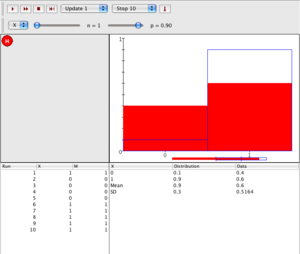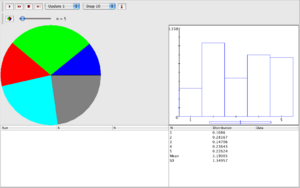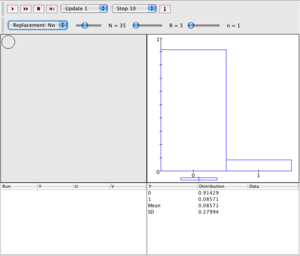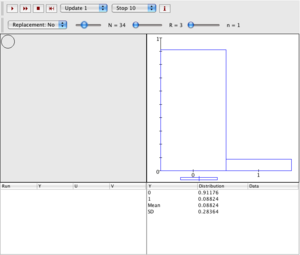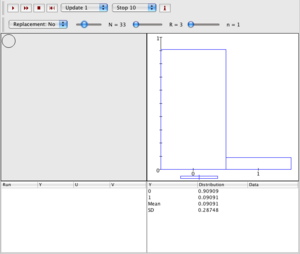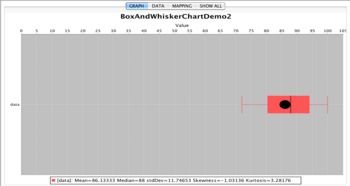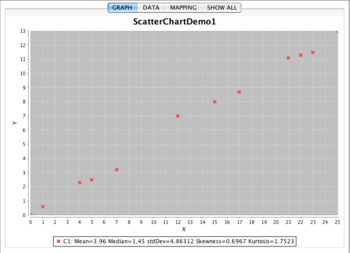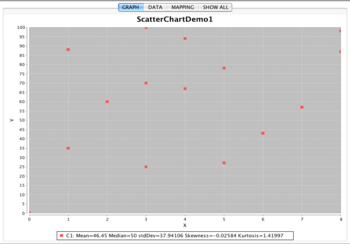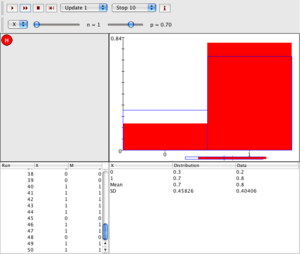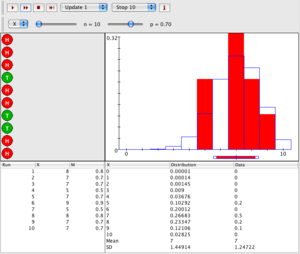K12 Education
From Socr
SOCR Educational Materials - SOCR K-12 Educational Materials
Overview
The SOCR K-12 educational resources are developed to provide specific guideance, hands-on activities, demonstrations and learning materials specifically for technology-enhanced elementary, midle and high school probability and statistics education.
General Curriculum Outline
There are large variations in the probability and statistics curricula based on age, geographic location, culture, economic, social and visionary settings. This curricular outline includes many of the commonly discussed topics, terminologies, properties and protocols for data-driven probability modeling and statistical analysis.
Calculating probabilities of events and compare theoretical and experimental probability
Use basic concepts of probability to determine the likelihood of an event and compare the results of various experiments
Statistics are often used in sports. For example, if you watch professional tennis players on television, the sports channels like to show the probability of a first serve landing inside the service box.
Say, for instance, that Roger Federer’s percentage of first serves in the service box is 90% (and that he serves that percentage consistently). What does this mean?
Use the Binomial Coin experiment. Set n = 1 (since he only has one chance to get his first serve in) and p = 0.9 (the probability that his service will be in the service box). Stop the experiment after 10 trials. Count the number of 1’s, which represent serves in. Repeat this experiment several times.
Around what number of 1’s does the experiment get each time? What does this predict about the number of serves Roger Federer will most likely serve into the box when he is only allowed 10 tries?
Display and compare data to make predictions and formulate conclusions
Graphs are very helpful in presenting data instead of simply showing numbers. For example, a graph is very useful in displaying the music content of an iPod.
Two graphs that work well are the histogram and the pie chart.
Graph the following data using the SOCR charts.
| Genre | Number of Songs |
| Jazz | 17 |
| Pop | 44 |
| Indie_Rock | 23 |
| Easy_Listening | 37 |
| Hip_Hop_R&B | 56 |
Now try applying this to the previous section about probabilities. How many times will the iPod play a certain genre if it is on random for 100 songs? The iPod is not keeping track of what it plays and so songs can be played twice ( sampling with replacement).
Your pie chart already gives you an idea of the probability of each genre. The bigger the area of a certain genre the greater the chance it will be played.
Using the SOCR spinner experiment, perform an experiment that will answer the question above. Set n = 5 since you have 5 genres. Click on the small spinner icon to change the probabilities of each section to the appropriate probability. For example, jazz would be 17/177 = 0.0960. Be sure that these probabilities add up to 1! Then set the experiment to stop 100.
Fill in the chart below.
| Genre | Number of Times Played | Proportion |
| Jazz | ||
| Pop | ||
| Indie Rock | ||
| Easy Listening | ||
| Hip Hop, R&B |
After solving for each genre’s probability, what do they predict about the number of songs that will be played from each genre if the iPod is running only 100 songs?
How well does the experiment’s data agree with the math?
Calculate probabilities of events and compare theoretical and experimental probability
You are going to buy new school supplies for school. There are five different things that are on your shopping list: a three ring binder, pencils, color pencils, a calculator, and folders.
For each of these items you have the following choices:
| Item | Different Kinds |
| Three Ring Binder | pockets, no pockets, or clear cover |
| Pencils | mechanical or regular |
| Color Pencils | Crayola, Rose Art, or Bic |
| Calculator | TI-83, regular, solar powered |
| Folders | plastic, paper with prongs, paper no prongs |
How many different ways can you choose your school supplies? Use the fundamental counting principle.
- Sampling without replacement
Door prize drawings - You and your parents attend a banquet at school. The school decides to have door prizes to make the event more fun. 35 students and parents are present and each of them are given a raffle ticket. Only one ticket is drawn at a time and once a ticket has won a prize, it can no longer be selected. What is the chance that your ticket or your parents' tickets are drawn?
To demonstrate how the probability that you or your parents’ tickets are drawn, use the SOCR Ball and Urn experiment. First run the experiment with the total number of tickets at 35. As you decrease the number of total tickets (as each winner’s ticket is removed from the group that is still able to win), how do you and your parents’ odds change? Do they increase or decrease with no replacement? What about with replacement?
Formulate questions and answer the questions by organizaing and analyzing data
Use percentile and measures of variability to analyze data
Standardized test scores are often reported in relation to all the test scores of other students. For example, when your test score is in the 95 percentile that means that you have a test score that is higher than 95% of the other students who took the test.
| Test Scores |
| 85 |
| 88 |
| 90 |
| 92 |
| 76 |
| 57 |
| 88 |
| 91 |
| 74 |
| 72 |
| 98 |
| 100 |
| 97 |
| 88 |
| 96 |
Use the range, quartiles, and IQR to evaluate each student’s performance. What is the range for this set of test scores? Find the three quartiles for the test scores. Also, what is another term for the second quartile? What is the IQR for this set of test scores?
- Charts and Plots
Box and whisker plots are a very useful way of displaying data that involves the range, quartiles and IQR. Using SOCR charts, enter in the data for the test scores to see if your answers are correct and view how the data looks in this type of graph. (Go to SOCR Charts, click on Miscellaneous, then Box and Whisker Chart Demo 2).
Summarize, display, and analyze bivariate data
Analyze bivariate data using linear regression methods
Graph the following using SOCR charts and look at the correlations.
- Use the scatter plot to plot the data.
Fish Weight Gain vs. Number of Worms Eaten
| Number of Worms Eaten | Weight Gain in Ounces |
| 1 | 0.6 |
| 12 | 7 |
| 7 | 3.2 |
| 25 | 13 |
| 17 | 8.7 |
| 15 | 8 |
| 5 | 2.5 |
| 4 | 2.3 |
| 21 | 11.1 |
| 23 | 11.5 |
| 22 | 11.3 |
Test Scores vs. Number of Cavities a Student Has
| Number of Cavities | Test Scores |
| 1 | 88 |
| 4 | 94 |
| 6 | 43 |
| 7 | 57 |
| 8 | 98 |
| 2 | 60 |
| 3 | 100 |
| 1 | 35 |
| 3 | 25 |
| 5 | 78 |
| 4 | 67 |
| 1 | 75 |
| 8 | 87 |
| 5 | 27 |
| 3 | 70 |
Are these positive, negative, or no correlation data sets?
- If the data set does have a correlation, use the line of best fit to determine a numerical relation and interpret it. For example, if the fish data set has a correlation, use the line of best fit to figure out how many ounces a fish would be expected to gain if it ate X number of worms.
Apply basic concepts of probability (permutations, combinations, conditional probabilities)
Stringing beads on a string:
| Bead Color | Number of Beads |
| Blue | 3 |
| Green | 4 |
| Yellow | 2 |
| Red | 2 |
1. permutation deals with order: how many different ways can you order the beads?
2. combination deals with grouping: how many ways can you group the beads?
- Conditional Probability - Probability Trees
It's Halloween. One of the houses has a basket of candy left out on the porch and inside is an assortment of candy:
| General Type of Candy | Specific Type |
| 5 mini Hershey bars | 2 are milk chocolate, 3 are dark chocolate |
| 7 Blow Pops | 2 Cherry, 2 Apple, 3 Grape |
| 3 packs of gum | 1 regular, 1 Juicy Fruit, 1 mint |
You decide to just take one piece. What is the probability that you will pick a dark chocolate Hershey bar? What about an apple Blow Pop? A pack of Juicy Fruit gum?
Compute Probabilities for discrete distributions and use sampling distributions to calculate approximate probabilities
Suppose you are trying to determine whether or not a fruit sale would be a successful method of fundraising at your school. To help you determine whether or not it would be a good idea, you decide to ask parents while they are waiting to pick up their children after school. They answer either “yes” or “no.”
According your results, the probability of success is 0.7 and the probability of failure is 0.3.
You decide to go ahead and have the fruit sale. You want to try and determine how many parents will agree to buy fruit if you ask 50 parents. Use the SOCR Binomial Coin Toss experiment again to help you predict how many parents will agree.
This is like the Bernoulli process except that now you are trying to find the number of successes in a certain number of trials. For example, for every group of 10 parents that you ask, what is the probability that 4 of them will say “yes”? What is the probability that at least 5 will say “yes”?
Use the SOCR Binomial Coin Toss experiment again to answer these questions.
Normal Distribution
The Normal distribution graph can predict the percentage of data within certain ranges using the standard deviation and mean of the data.
Depending on the Binomial distribution parameters, the normal distribution can also be used to solve for Binomial distribution
See also
- SOCR ASA MWM Webinar on Middle/High School Probability and Statistics Education
- Interactive Statistics Education EBook
- SOCR Home page: http://www.socr.ucla.edu
Translate this page:
